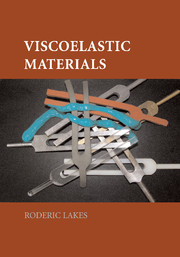Book contents
- Frontmatter
- Contents
- Preface
- 1 Introduction: Phenomena
- 2 Constitutive Relations
- 3 Dynamic Behavior
- 4 Conceptual Structure of Linear Viscoelasticity
- 5 Viscoelastic Stress and Deformation Analysis
- 6 Experimental Methods
- 7 Viscoelastic Properties of Materials
- 8 Causal Mechanisms
- 9 Viscoelastic Composite Materials
- 10 Applications and Case Studies
- A Appendix
- B Symbols
- Index
8 - Causal Mechanisms
Published online by Cambridge University Press: 21 January 2010
- Frontmatter
- Contents
- Preface
- 1 Introduction: Phenomena
- 2 Constitutive Relations
- 3 Dynamic Behavior
- 4 Conceptual Structure of Linear Viscoelasticity
- 5 Viscoelastic Stress and Deformation Analysis
- 6 Experimental Methods
- 7 Viscoelastic Properties of Materials
- 8 Causal Mechanisms
- 9 Viscoelastic Composite Materials
- 10 Applications and Case Studies
- A Appendix
- B Symbols
- Index
Summary
Introduction
Rationale
The treatment of viscoelasticity thus far has dealt with phenomena, measurement of material properties, prediction of response to various load histories, and stress analysis. In this chapter we consider the physical causes of viscoelastic response. Study of causal mechanisms is motivated by (1) the desire for scientific understanding; (2) the intention to gain ability to choose or tailor materials with specified viscoelastic properties; and (3) the utility of viscoelastic measurements as a probe of microphysical processes that are causally linked to viscoelasticity. The conceptually simplest of the causal mechanisms are developed in detail here. These processes can occur in crystalline materials including metals, ceramics as well as in polymers. Examples of damping due to fluid–solid interaction in porous materials according to the Biot theory are given in §7.5, biological tissue. Viscoelasticity in tissue also results from stress induced motion at the molecular scale. The treatment is intended to be introductory, not exhaustive.
Survey of Viscoelastic Mechanisms
There are many causal mechanisms [1–3] responsible for viscoelastic response; several of these are as follows. Mechanisms indicated by a * are called fundamental mechanisms because they occur even in an ideal perfect single crystal, and they are not removable, even in principle. Many effects are named for the person who discovered them or who provided a clear analysis of the physical processes responsible for them. The word relaxation is used in these names to refer to viscoelasticity in a general sense, not necessarily a specific stress relaxation experiment.
- Type
- Chapter
- Information
- Viscoelastic Materials , pp. 271 - 340Publisher: Cambridge University PressPrint publication year: 2009



